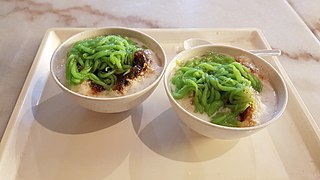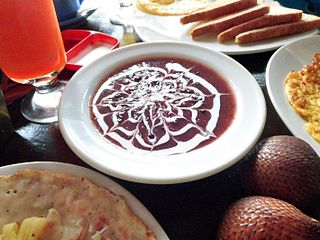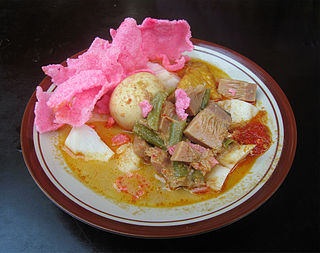Trancam is a typical dish of Central Java which is similar to urap, consisting of bean sprouts, long beans, lemon basil leaves and finely sliced napa cabbage. Everything is served fresh, stirred with grated coconut and seasoned with garlic, chili pepper and kencur.
According to sajiansedap.com via Kompas.com, trancam is one of urap variants. Most of the ingredients are still raw including vegetables and seasonings, except the coconut which is steamed. [1]

Indonesian cuisine is a collection of various regional culinary traditions that formed in the archipelagic nation of Indonesia. There are a wide variety of recipes and cuisines in part because Indonesia is composed of approximately 6,000 populated islands of the total 17,508 in the world's largest archipelago, with more than 1,300 ethnic groups.

Nasi uduk is an Indonesian-style steamed rice cooked in coconut milk dish, especially popular in Betawi cuisine.

Cendol is an iced sweet dessert that contains droplets of pandan-flavoured green rice flour jelly, coconut milk and palm sugar syrup. It is commonly found in Southeast Asia and is popular in Indonesia, Malaysia, Brunei, Cambodia, East Timor, Laos, Vietnam, Thailand, Singapore, Philippines, and Myanmar. Next to the green jelly, additional toppings might be added, including diced jackfruit, sweetened red azuki beans, or durian.

Pecel is a traditional Javanese salad with peanut sauce, usually eaten with carbs.

Bakpia pathok is a small, round-shaped Chinese-influenced Indonesian sweet roll (bakpia), usually stuffed with mung beans, but have recently come in other fillings as well, e.g. chocolate, durian and cheese. This sweet roll is found in Javanese and Chinese Indonesian cuisine. They are one of Yogyakarta's specialties and named after the Pathok suburb where the pastries originated.

Lontong is an Indonesian dish made of compressed rice cake in the form of a cylinder wrapped inside a banana leaf, commonly found in Indonesia, Malaysia, and Singapore. Rice is rolled inside a banana leaf and boiled, then cut into small cakes as a staple food replacement for steamed rice. The texture is similar to that of ketupat, with the difference being that the ketupat container is made from woven janur fronds, while lontong uses banana leaf instead.

Tumpeng is an Indonesian cone-shaped rice dish with side dishes of vegetables and meat originating from Javanese cuisine of Indonesia. Traditionally featured in the slamatan ceremony, the rice is made by using a cone-shaped woven bamboo container. The rice itself may be plain steamed rice, uduk rice, or yellow rice.

Mie celor is a Southeast Asian noodle soup dish served in a coconut milk and shrimp-based broth, specialty of Palembang city, South Sumatra, Indonesia.

Rempeyek or peyek is a deep-fried savoury Indonesian-Javanese cracker made from flour with other ingredients, bound or coated by crispy flour batter. The most common type of rempeyek is peyek kacang ; However, other ingredients can be used instead, such as teri, rebon, or ebi. Today, rempeyek is commonly found in Indonesia and Malaysia, as well as in countries with considerable Indonesian migrant populations, such as The Netherlands and Suriname.

Urap is a salad dish of steamed vegetables mixed with seasoned and spiced grated coconut for dressing. It is commonly found in Indonesian cuisine, more precisely Javanese cuisine. Urap can be consumed on its own as a salad for vegetarian meals or as a side dish. Urap is usually found as a prerequisite side dish of Javanese tumpeng, a cone-shaped rice mound surrounded with assorted dishes, as well as part of a nasi kuning dish. In Balinese cuisine, it is known as Urab sayur.
Kuluban is a traditional salad of Central Java. Kuluban can be consumed on its own as a salad for vegetarian meals or as a side dish. Kuluban is one of ancient Javanese cuisine, as it was mentioned in inscription dated from Medang Mataram era circa 9th century CE.

Bubur ketan hitam, bubur pulut hitam or bubur injun is an Indonesian sweet dessert made from black glutinous rice porridge with coconut milk and palm sugar or cane sugar. The black glutinous rice are boiled until soft, and sugar and coconut milk are added. It is often described as "black glutinous rice pudding" and is very similar to black rice tong sui made from black rice. It is often served as dessert or snack, for supper, for tea time, anytime of the day; however, it is a popular choice for breakfast for those who prefer sweet treat instead of its savory counterpart bubur ayam.

Plecing kangkung is an Indonesian spicy water spinach dish from the island of Bali and Lombok. Plecing kangkung is made from blanched water spinach leaves and served cold with plecing sambal made from ground red chili pepper, shallot, garlic, bird's eye chili, candlenut, kaffir lime, shrimp paste, salt, and sugar. As a side for the Lomboknese dish Ayam taliwang and Balinese dish Ayam Betutu, plecing kangkung is also usually served with additional ingredients such as bean sprouts, string beans, fried peanuts, and urap's grated spicy coconut dressing.

Soto is a traditional Indonesian soup mainly composed of broth, meat, and vegetables. Many traditional soups are called soto, whereas foreign and Western influenced soups are called sop.

Lawar is an Indonesian dish created from a mixture of vegetables, coconut, and minced meat mixed with rich herbs and spices, originating from Bali, Indonesia. This dish is commonly found in restaurants and warungs in Bali. Despite its rich vegetable mixture, lawar is not a vegetarian dish, since most often it is mixed with minced meat or even blood.

Gado-gado is an Indonesian salad of raw, slightly boiled, blanched or steamed vegetables and hard-boiled eggs, boiled potato, fried tofu and tempeh, and sliced lontong, served with a peanut sauce dressing.

Lontong sayur is an Indonesian traditional rice dish made of pieces of lontong served in coconut milk soup with shredded chayote, green bean, unripe jackfruit, tempeh, tofu, hard-boiled egg, sambal and krupuk.

Brongkos is a Javanese spicy meat and beans stew, specialty of Yogyakarta and other cities in Central Java, Indonesia.

Indonesian noodles are a significant aspect of Indonesian cuisine which is itself very diverse. Indonesian cuisine recognizes many types of noodles, with each region of the country often developing its own distinct recipes.